Abstract
1. The effects of two reversible, predominantly monoamine oxidase-A (MAO-A) inhibitors, moclobemide (150 mg three times daily) and toloxatone (400-200-400 mg day-1) on monoamine metabolites and psychometric performance were compared in a double-blind placebo controlled crossover study in 12 healthy subjects. 2. After 7 days of moclobemide/toloxatone/placebo administration subjects were hospitalized for 24 h on day 8. Blood samples were drawn every 2 h for determination of plasma noradrenaline (NA), 3,4-dihydroxyphenylglycol (DHPG), homovanillic acid (HVA) and 5-hydroxyindolacetic acid (5-HIAA). Urine was collected for measurements of normetanephrine and 3-methoxytyramine excretion. Psychometric performance (short- and long-term memory, critical flicker fusion frequency, choice reaction time) and subjective feelings were assessed before each drug intake (in the morning, at noon, in the evening). 3. Compared with placebo, both reversible monoamine oxidase inhibitors decreased the plasma concentration of DHPG and HVA. The overall fall in DHPG (AUC from 0 to 24 h) was 44% during moclobemide and 12% during toloxatone (P less than 0.001) and the overall decrease in HVA was 38% and 20% (P less than 0.005) on moclobemide and toloxatone, respectively. 4. Before the next drug intake, MAO-A inhibition, as judged by the decrease of plasma DHPG concentration, was significantly different from placebo with moclobemide but not with toloxatone. 5. Moclobemide, but not toloxatone, exerted a moderate, but significant inhibition of the deamination of 5-hydroxytryptamine (5-HT) as judged by the fall in plasma 5-HIAA concentration. Neither drug influenced plasma NA concentration. 6. A significant rise in urinary excretion of normetanephrine was observed on moclobemide and to a lesser extent on toloxatone. The urinary excretion of 3-methoxytyramine was significantly raised by moclobemide but not by toloxatone. 7. Neither moclobemide nor toloxatone altered memory function, vigilance, subjective feelings or sleep characteristics of the subjects.
Full text
PDF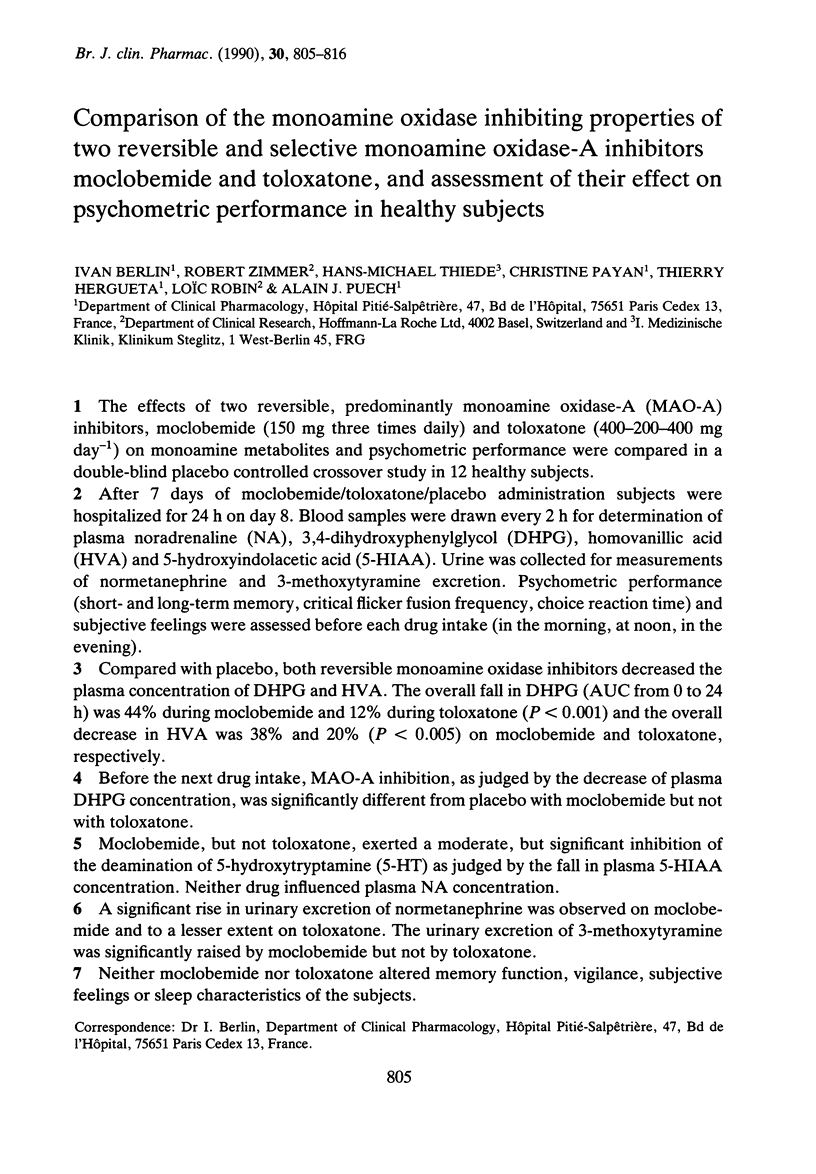
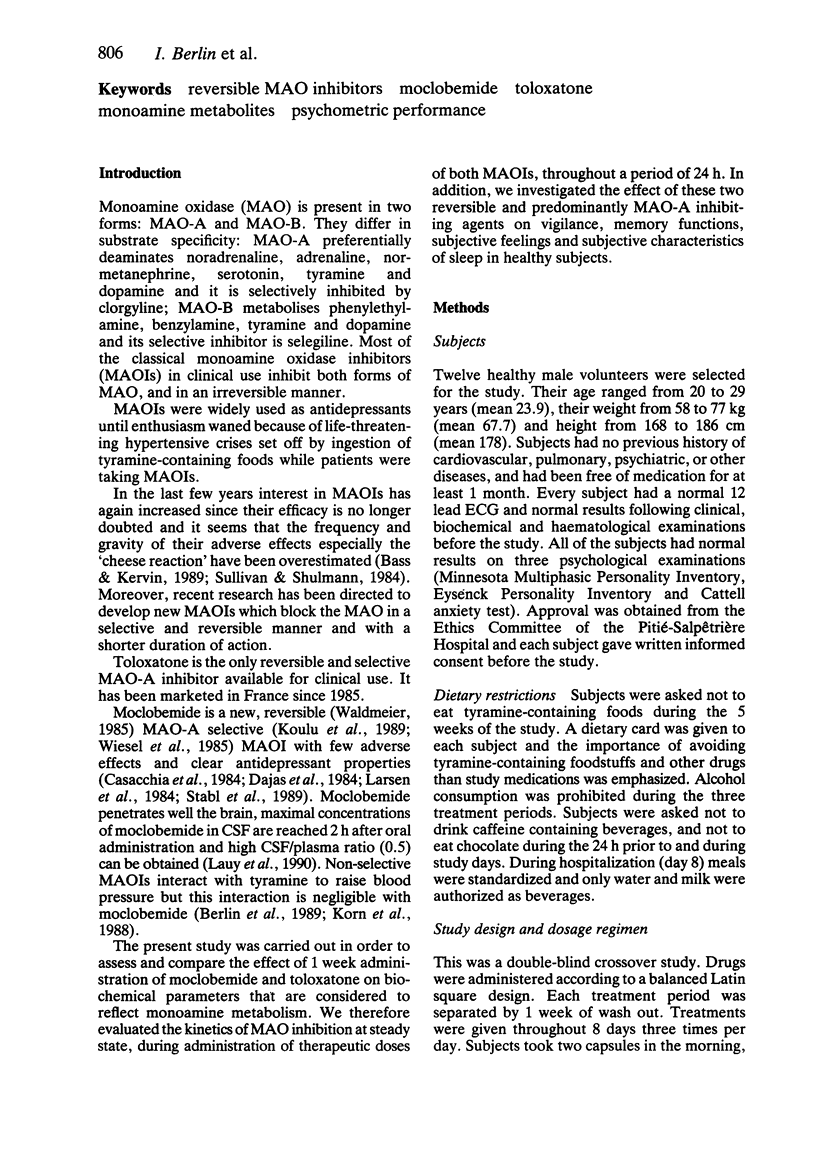
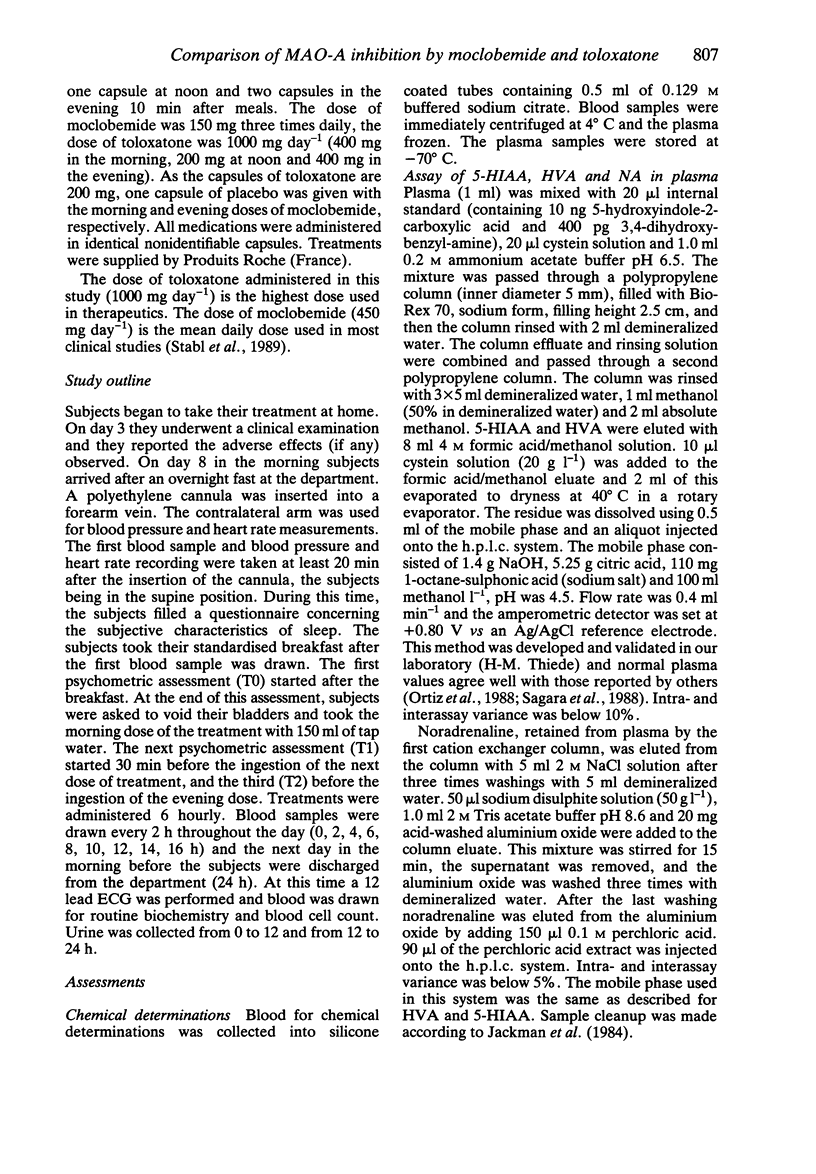
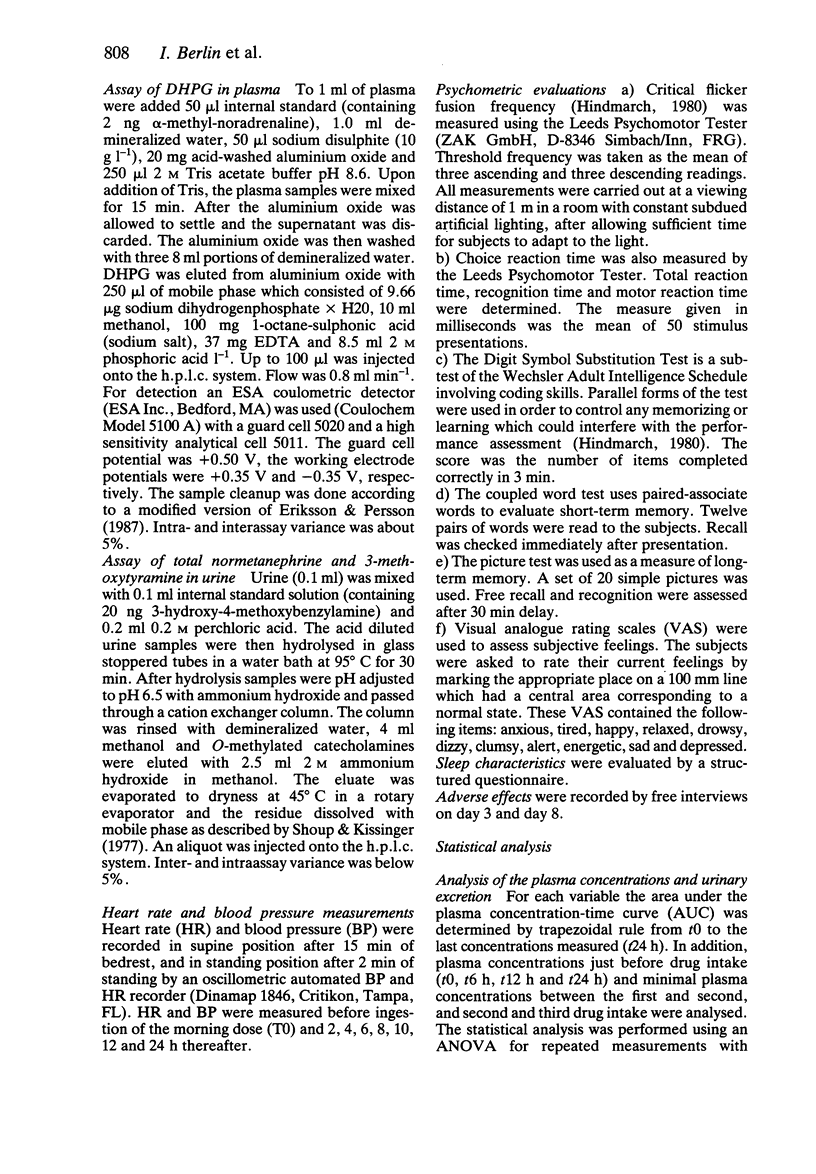
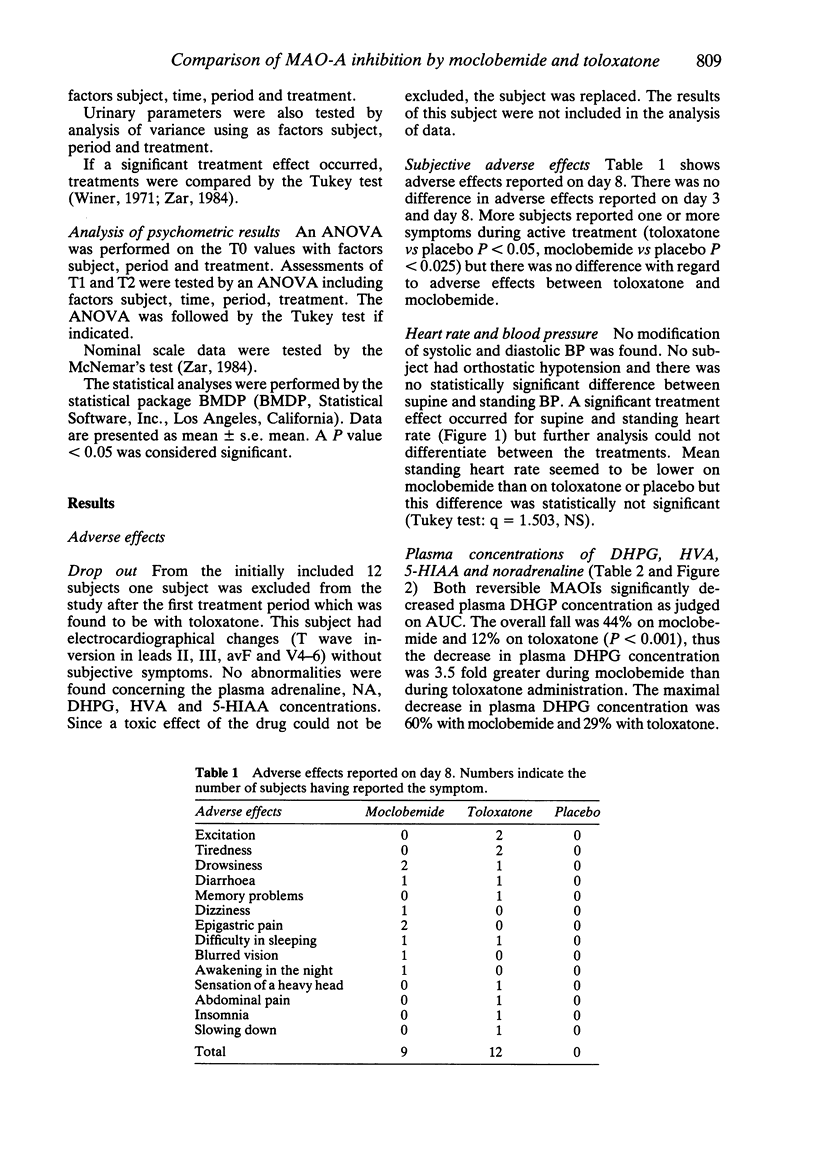
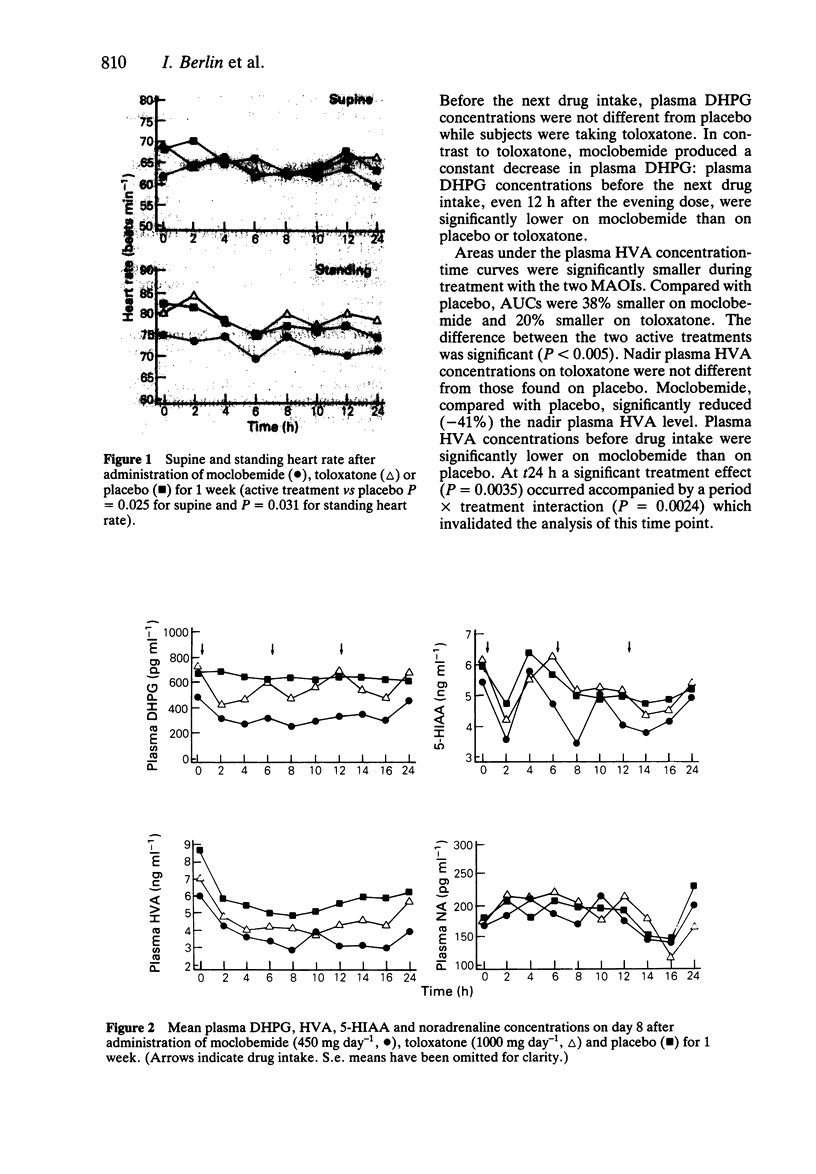
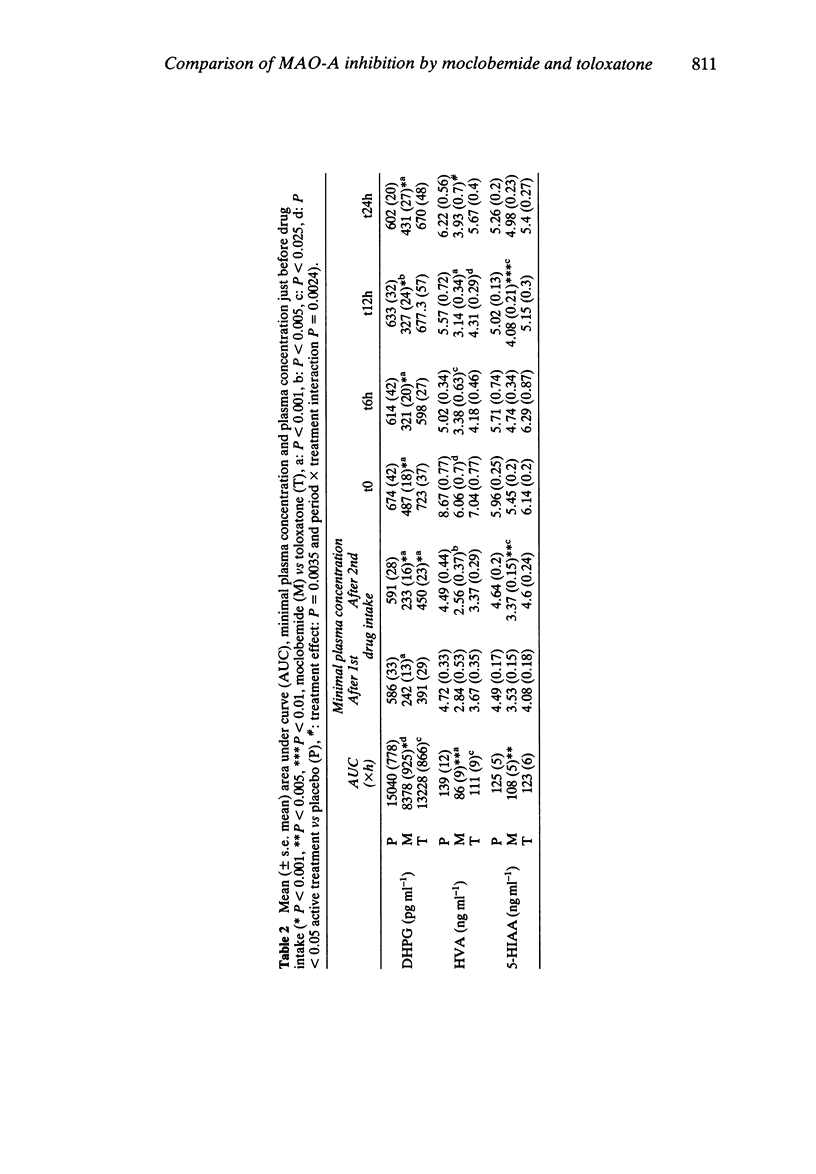
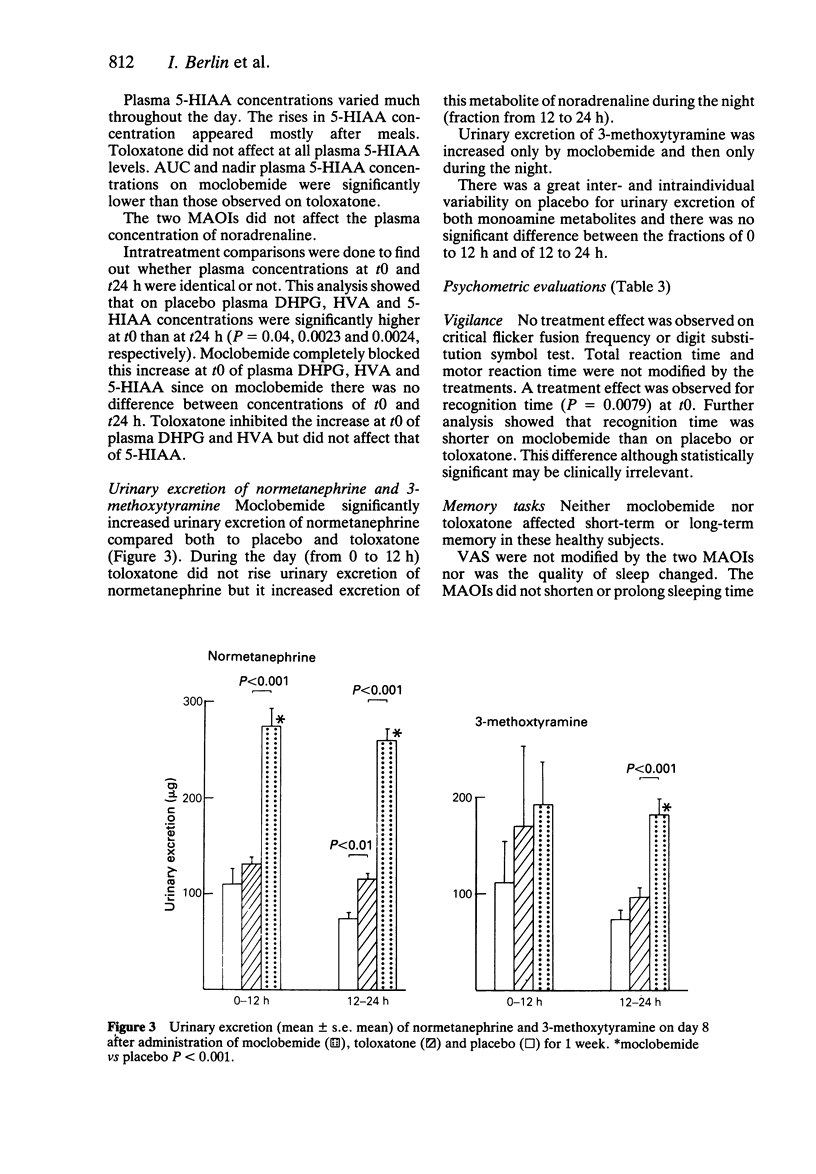
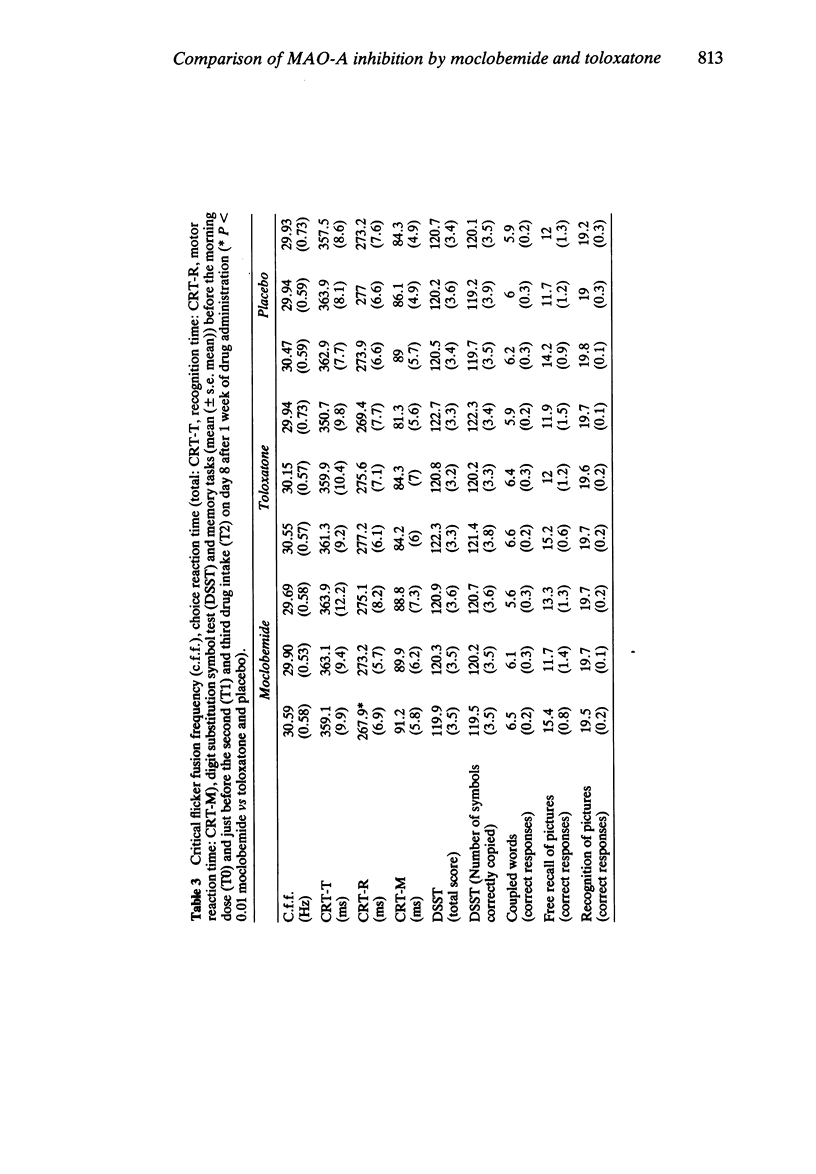
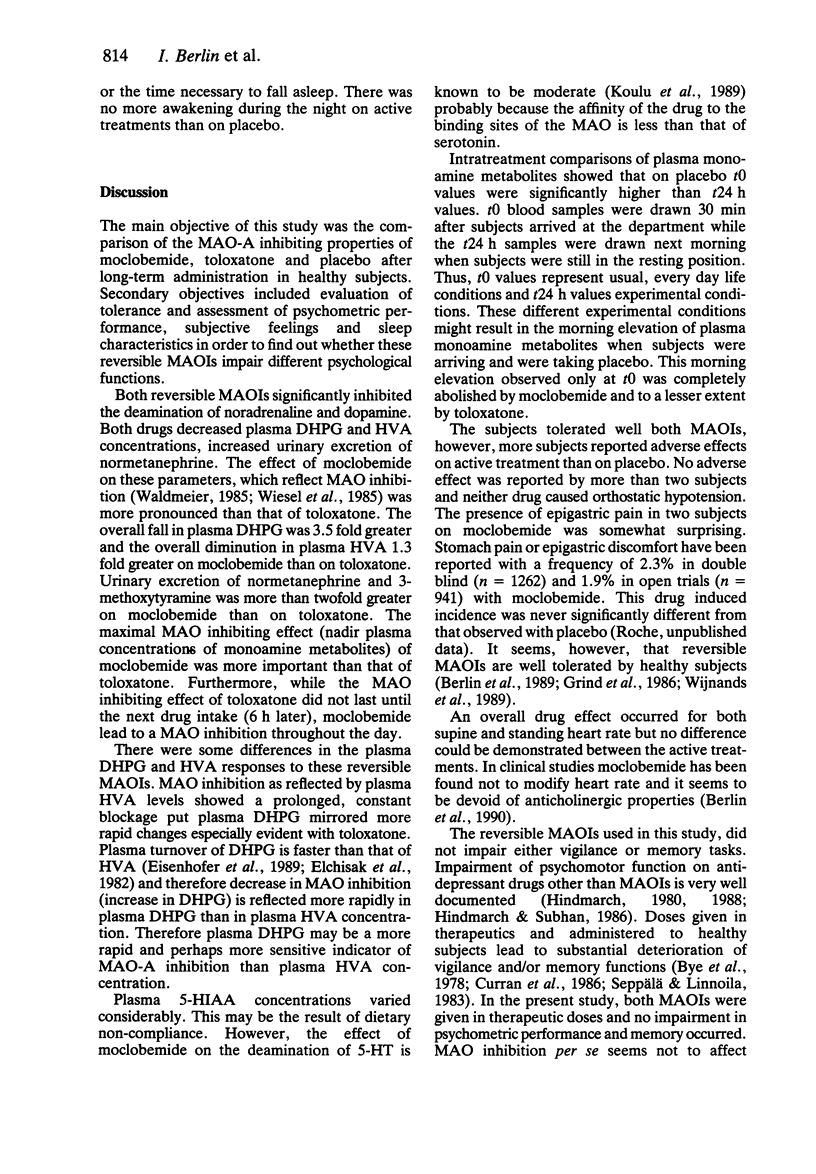
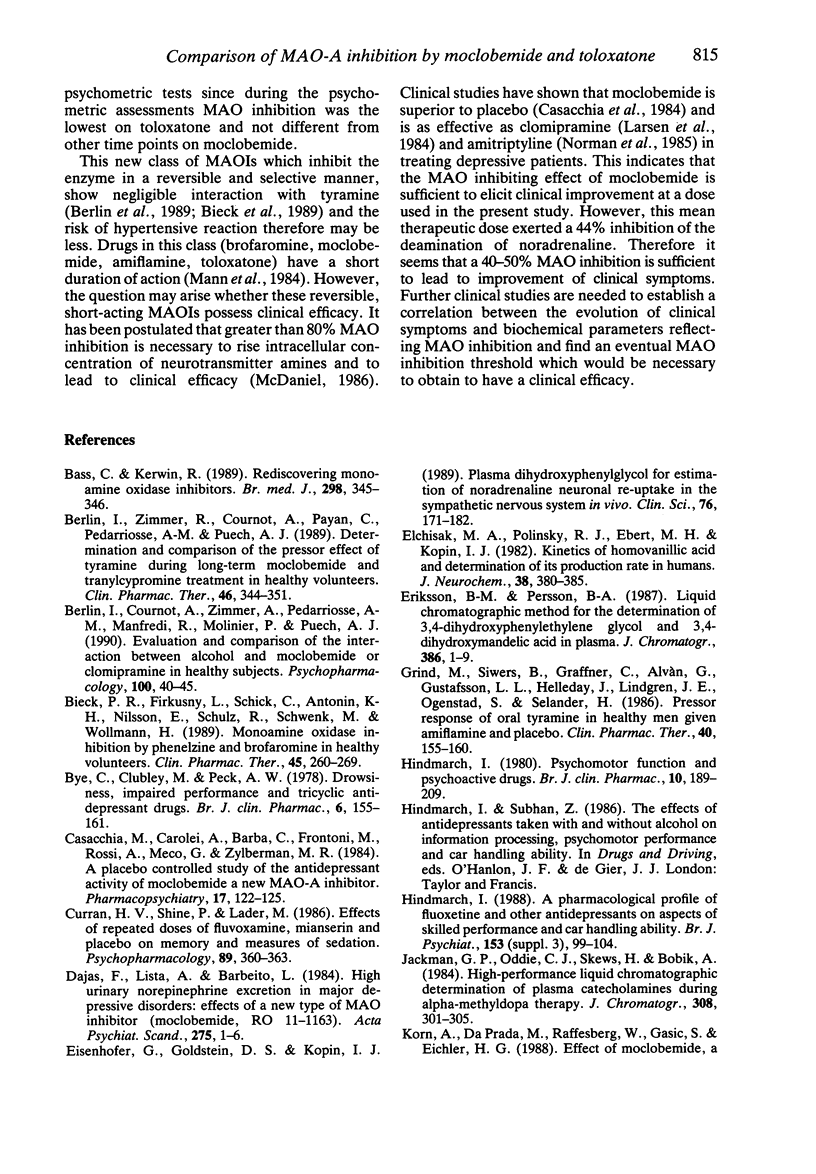
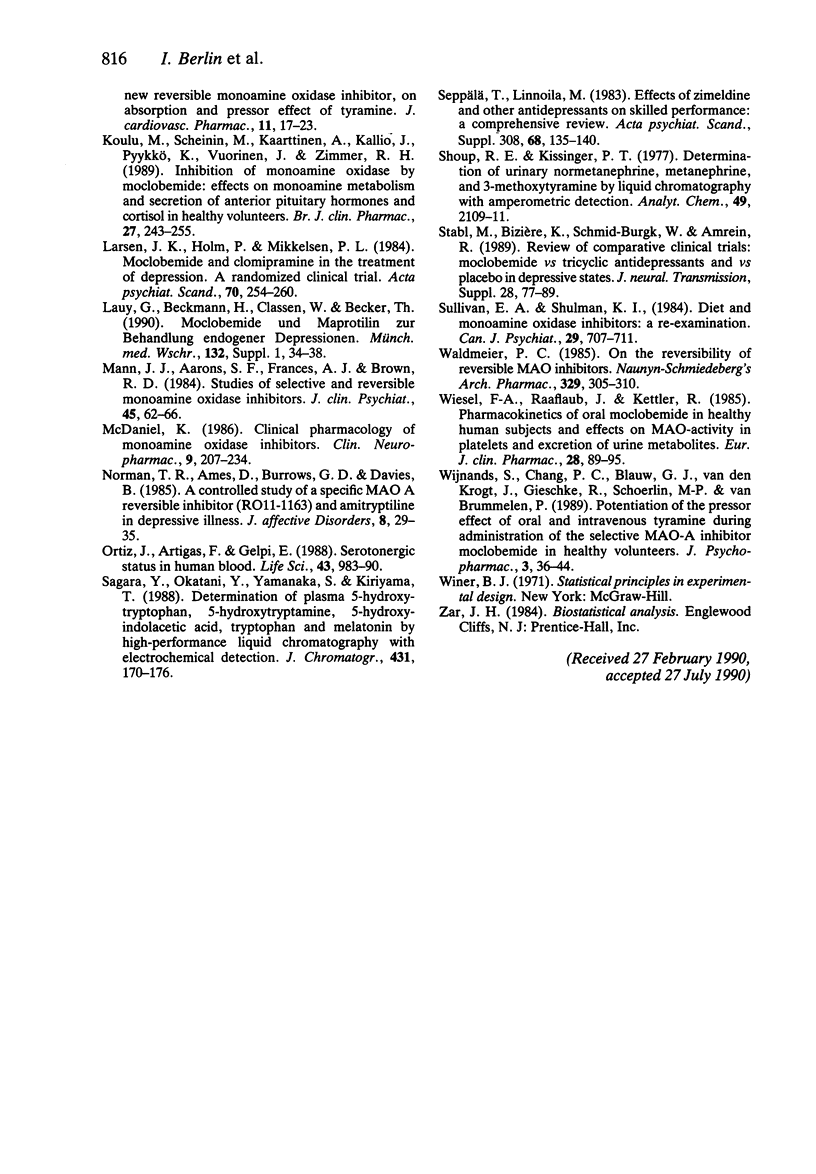
Selected References
These references are in PubMed. This may not be the complete list of references from this article.
- Bass C., Kerwin R. Rediscovering monoamine oxidase inhibitors. BMJ. 1989 Feb 11;298(6670):345–346. doi: 10.1136/bmj.298.6670.345. [DOI] [PMC free article] [PubMed] [Google Scholar]
- Berlin I., Cournot A., Zimmer R., Pedarriosse A. M., Manfredi R., Molinier P., Puech A. J. Evaluation and comparison of the interaction between alcohol and moclobemide or clomipramine in healthy subjects. Psychopharmacology (Berl) 1990;100(1):40–45. doi: 10.1007/BF02245787. [DOI] [PubMed] [Google Scholar]
- Berlin I., Zimmer R., Cournot A., Payan C., Pedarriosse A. M., Puech A. J. Determination and comparison of the pressor effect of tyramine during long-term moclobemide and tranylcypromine treatment in healthy volunteers. Clin Pharmacol Ther. 1989 Sep;46(3):344–351. doi: 10.1038/clpt.1989.149. [DOI] [PubMed] [Google Scholar]
- Bieck P. R., Firkusny L., Schick C., Antonin K. H., Nilsson E., Schulz R., Schwenk M., Wollmann H. Monoamine oxidase inhibition by phenelzine and brofaromine in healthy volunteers. Clin Pharmacol Ther. 1989 Mar;45(3):260–269. doi: 10.1038/clpt.1989.26. [DOI] [PubMed] [Google Scholar]
- Bye C., Clubley M., Peck A. W. Drowsiness, impaired performance and tricyclic antidepressants drugs. Br J Clin Pharmacol. 1978 Aug;6(2):155–162. doi: 10.1111/j.1365-2125.1978.tb00841.x. [DOI] [PMC free article] [PubMed] [Google Scholar]
- Casacchia M., Carolei A., Barba C., Frontoni M., Rossi A., Meco G., Zylberman M. R. A placebo-controlled study of the antidepressant activity of moclobemide, a new MAO-A inhibitor. Pharmacopsychiatry. 1984 Jul;17(4):122–125. doi: 10.1055/s-2007-1017421. [DOI] [PubMed] [Google Scholar]
- Curran H. V., Shine P., Lader M. Effects of repeated doses of fluvoxamine, mianserin and placebo on memory and measures of sedation. Psychopharmacology (Berl) 1986;89(3):360–363. doi: 10.1007/BF00174375. [DOI] [PubMed] [Google Scholar]
- Eisenhofer G., Goldstein D. S., Kopin I. J. Plasma dihydroxyphenylglycol for estimation of noradrenaline neuronal re-uptake in the sympathetic nervous system in vivo. Clin Sci (Lond) 1989 Feb;76(2):171–182. doi: 10.1042/cs0760171. [DOI] [PubMed] [Google Scholar]
- Elchisak M. A., Polinsky R. J., Ebert M. H., Kopin I. J. Kinetics of homovanillic acid and determination of its production rate in humans. J Neurochem. 1982 Feb;38(2):380–385. doi: 10.1111/j.1471-4159.1982.tb08640.x. [DOI] [PubMed] [Google Scholar]
- Eriksson B. M., Persson B. A. Liquid chromatographic method for the determination of 3,4-dihydroxyphenylethylene glycol and 3,4-dihydroxymandelic acid in plasma. J Chromatogr. 1987 Jan 16;386:1–9. doi: 10.1016/s0021-9673(01)94578-9. [DOI] [PubMed] [Google Scholar]
- Grind M., Siwers B., Graffner C., Alván G., Gustafsson L. L., Helleday J., Lindgren J. E., Ogenstad S., Selander H. Pressor response of oral tyramine in healthy men given amiflamine and placebo. Clin Pharmacol Ther. 1986 Aug;40(2):155–160. doi: 10.1038/clpt.1986.157. [DOI] [PubMed] [Google Scholar]
- Hindmarch I. A pharmacological profile of fluoxetine and other antidepressants on aspects of skilled performance and car handling ability. Br J Psychiatry Suppl. 1988 Sep;(3):99–104. [PubMed] [Google Scholar]
- Hindmarch I. Psychomotor function and psychoactive drugs. Br J Clin Pharmacol. 1980 Sep;10(3):189–209. doi: 10.1111/j.1365-2125.1980.tb01745.x. [DOI] [PMC free article] [PubMed] [Google Scholar]
- Jackman G. P., Oddie C. J., Skews H., Bobik A. High-performance liquid chromatographic determination of plasma catecholamines during alpha-methyldopa therapy. J Chromatogr. 1984 Jun 8;308:301–305. doi: 10.1016/s0021-9673(01)87557-9. [DOI] [PubMed] [Google Scholar]
- Korn A., Da Prada M., Raffesberg W., Gasic S., Eichler H. G. Effect of moclobemide, a new reversible monoamine oxidase inhibitor, on absorption and pressor effect of tyramine. J Cardiovasc Pharmacol. 1988 Jan;11(1):17–23. doi: 10.1097/00005344-198801000-00003. [DOI] [PubMed] [Google Scholar]
- Koulu M., Scheinin M., Kaarttinen A., Kallio J., Pyykkö K., Vuorinen J., Zimmer R. H. Inhibition of monoamine oxidase by moclobemide: effects on monoamine metabolism and secretion of anterior pituitary hormones and cortisol in healthy volunteers. Br J Clin Pharmacol. 1989 Feb;27(2):243–255. doi: 10.1111/j.1365-2125.1989.tb05357.x. [DOI] [PMC free article] [PubMed] [Google Scholar]
- Larsen J. K., Holm P., Mikkelsen P. L. Moclobemide and clomipramine in the treatment of depression. A randomized clinical trial. Acta Psychiatr Scand. 1984 Sep;70(3):254–260. doi: 10.1111/j.1600-0447.1984.tb01206.x. [DOI] [PubMed] [Google Scholar]
- Mann J. J., Aarons S. F., Frances A. J., Brown R. D. Studies of selective and reversible monoamine oxidase inhibitors. J Clin Psychiatry. 1984 Jul;45(7 Pt 2):62–66. [PubMed] [Google Scholar]
- McDaniel K. D. Clinical pharmacology of monoamine oxidase inhibitors. Clin Neuropharmacol. 1986;9(3):207–234. doi: 10.1097/00002826-198606000-00001. [DOI] [PubMed] [Google Scholar]
- Norman T. R., Ames D., Burrows G. D., Davies B. A controlled study of a specific MAO A reversible inhibitor (R011-1163) and amitriptyline in depressive illness. J Affect Disord. 1985 Jan-Feb;8(1):29–35. doi: 10.1016/0165-0327(85)90069-2. [DOI] [PubMed] [Google Scholar]
- Ortiz J., Artigas F., Gelpí E. Serotonergic status in human blood. Life Sci. 1988;43(12):983–990. doi: 10.1016/0024-3205(88)90543-7. [DOI] [PubMed] [Google Scholar]
- Riggin R. M., Kissinger P. T. Determination of catecholamines in urine by reverse-phase liquid chromatography with electrochemical detection. Anal Chem. 1977 Nov;49(13):2109–2111. doi: 10.1021/ac50021a052. [DOI] [PubMed] [Google Scholar]
- Sagara Y., Okatani Y., Yamanaka S., Kiriyama T. Determination of plasma 5-hydroxytryptophan, 5-hydroxytryptamine, 5-hydroxyindoleacetic acid, tryptophan and melatonin by high-performance liquid chromatography with electrochemical detection. J Chromatogr. 1988 Sep 23;431(1):170–176. doi: 10.1016/s0378-4347(00)83081-9. [DOI] [PubMed] [Google Scholar]
- Seppälä T., Linnoila M. Effects of zimeldine and other antidepressants on skilled performance: a comprehensive review. Acta Psychiatr Scand Suppl. 1983;308:135–140. doi: 10.1111/j.1600-0447.1983.tb11114.x. [DOI] [PubMed] [Google Scholar]
- Stabl M., Biziére K., Schmid-Burgk W., Amrein R. Review of comparative clinical trials. Moclobemide vs tricyclic antidepressants and vs placebo in depressive states. J Neural Transm Suppl. 1989;28:77–89. [PubMed] [Google Scholar]
- Sullivan E. A., Shulman K. I. Diet and monoamine oxidase inhibitors: a re-examination. Can J Psychiatry. 1984 Dec;29(8):707–711. doi: 10.1177/070674378402900814. [DOI] [PubMed] [Google Scholar]
- Waldmeier P. C. On the reversibility of reversible MAO inhibitors. Naunyn Schmiedebergs Arch Pharmacol. 1985 May;329(3):305–310. doi: 10.1007/BF00501885. [DOI] [PubMed] [Google Scholar]
- Wiesel F. A., Raaflaub J., Kettler R. Pharmacokinetics of oral moclobemide in healthy human subjects and effects on MAO-activity in platelets and excretion of urine monoamine metabolites. Eur J Clin Pharmacol. 1985;28(1):89–95. doi: 10.1007/BF00635714. [DOI] [PubMed] [Google Scholar]


